A technical SEO audit helps ensure that your website is well-positioned to serve the needs of both site visitors and search engines. And a technical SEO audit checklist helps growing companies stay organized as they evaluate the effectiveness and user experience of their site.
Conducting a technical SEO audit can also help you capitalize on revenue opportunities. B2B companies generate 2X more revenue from organic search than any other channel. A little extra effort to optimize your website can go a long way in helping you achieve your goals.
The goal of any web page — whether it’s optimized for search or not — is to serve up valuable content that’s relevant to your site visitors. Google, the world’s most popular search engine, prioritizes content that satisfies its E-E-A-T guidelines: web pages that are optimized for experience, expertise, authoritativeness and trustworthiness.
But great content isn’t enough. You must also ensure that when a visitor arrives, you’ve brought them to a high-performing site — a site that has the right layout, load speed and usability to help them find what they need.
That’s where technical search engine optimization (SEO) comes into play.
The York IE website and digital marketing team helps growing technology companies conduct technical SEO audits, diagnose potential issues and optimize sites for searchability and user experience.
Let’s dive deeper into some of the best practices we’ve learned along the way. Given that Google accounts for about 92% of search engine traffic, we’ll focus on optimizing your site for Google searches.
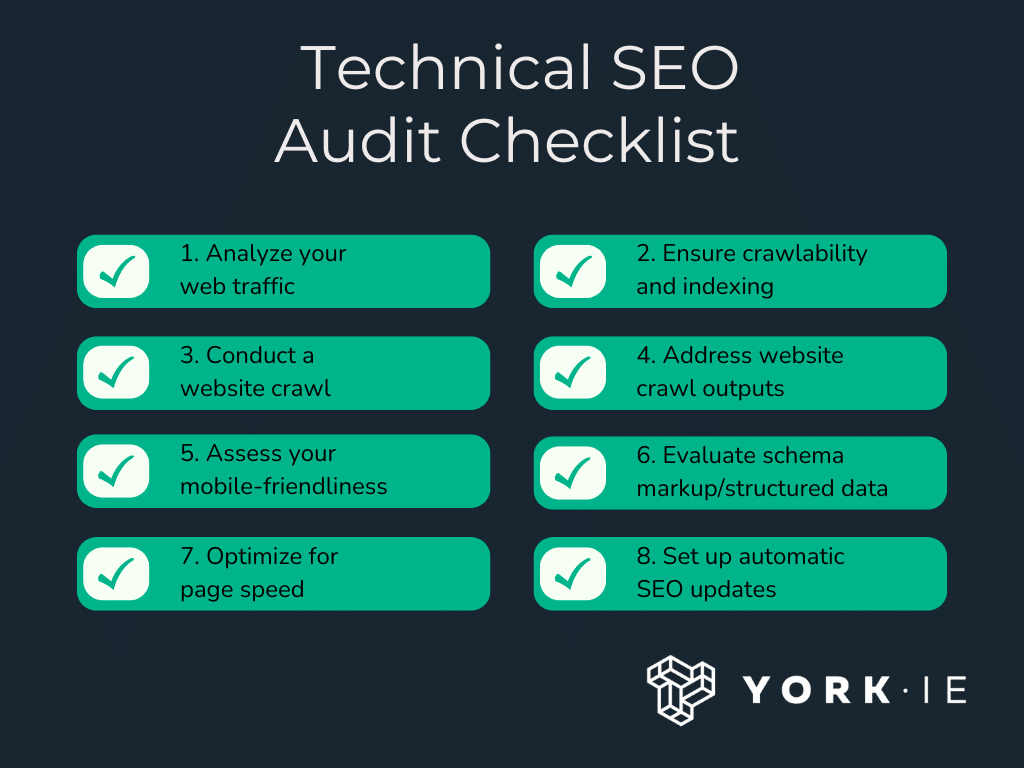
What Is Technical SEO?
Technical SEO is a process that involves optimizing the backend of a website to help search engines more effectively crawl, index and rank the site. A robust technical SEO strategy can increase the online visibility of your company, helping your site rank well in search engines and attract organic traffic.
Technical SEO vs. On-Page SEO vs. Off-Page SEO
SEO is a multi-layered concept. We like to think about three main aspects of SEO: on-page, off-page and technical. There is some natural overlap between these categories:
On-Page SEO
On-Page SEO involves optimizing individual web pages to rank higher in search results and drive more relevant search traffic. It primarily deals with website copy, meta tags, headings and images, with a focus on improving the user experience and providing valuable content to visitors.
Off-Page SEO
Off-Page SEO refers to activities done outside of the website to improve its search engine rankings. This process involves building backlinks from other reputable sites, social media marketing and partner/influencer collaborations. Off-page SEO helps to establish the authority and credibility of a website in the eyes of search engines.
Technical SEO
Technical SEO focuses on the backend of the website, ensuring search engines can crawl, index and rank it effectively. It involves optimizing for website speed, mobile-friendliness and overall user experience.
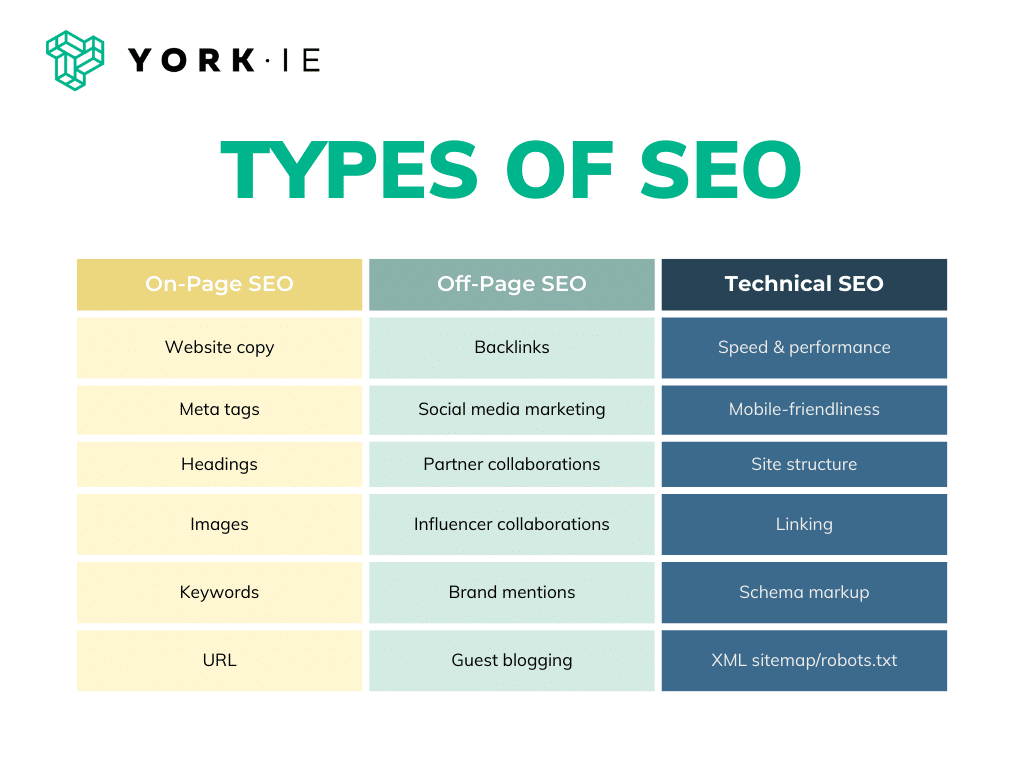
What Is a Technical SEO Audit?
A technical SEO audit is a process that helps you identify and address the back-end aspects of your website that contribute to your search rankings and user experience. It’s important for growing technology companies to conduct technical SEO audits on a quarterly basis to ensure their site is well-positioned to serve up valuable content and drive traffic.
What Should Be Included in a Technical SEO Audit?
A technical SEO audit should evaluate your website’s:
- speed and performance
- mobile-friendliness
- site structure and internal linking
- indexing and crawlability
- redirects and canonical tags
- schema markup and structured data
- XML sitemap and robots.txt file
The thoroughness of your audit depends on the maturity of your company and website. Early-stage companies might consider a lighter audit, while more mature organizations can get more granular in their evaluation. Either way, a technical SEO audit checklist can help you organize your process.
How to Perform a Technical SEO Audit
To perform a technical SEO audit, you should:
- Analyze your web traffic
- Ensure proper crawlability and indexing
- Conduct a website crawl
- Address website crawl outputs
- Assess your mobile-friendliness
- Evaluate your schema markup and structured data
- Optimize for page speed
- Set up automatic technical SEO updates
1. Analyze your web traffic
It’s important to start your audit by establishing benchmarks for your website. Use tools such as Google Search Console and/or Google Analytics to assess the trends of your site and understand how much traffic organic search is already driving for your site.
Doing so will help you prioritize your next steps based on your individual site’s needs. It will also allow you to measure improvement once you’ve completed the rest of your technical SEO audit.
2. Ensure proper crawling and indexing
Search engines first crawl the internet to discover web pages and online data. Next up is indexing, the process by which search engines collect, sort and store web pages for easy recall. Your pages won’t rank highly in search results if the search engine can’t crawl and index them first.
It’s often helpful to start with your XML sitemap, a document that shows search engines the overall hierarchy and structure of your website. Your sitemap shows the relationships between content within your website. Content management systems such as WordPress commonly include the ability to create XML sitemaps. You can also utilize Google Search Console or Screaming Frog to create or update your sitemap.
Additionally, a file known as robots.txt will tell search engines which pages it should and shouldn’t crawl. For example, you might host a gated eBook on your site that’s meant to drive new leads. You’ll want that page to stay hidden in search results so that only those who fill out your form can see it.
To find this file, simply add /robots.txt to your domain name in the search bar. From there, you can use Google’s robots.txt tester to identify any pages that aren’t being crawled — and therefore have no chance to show up in search results.
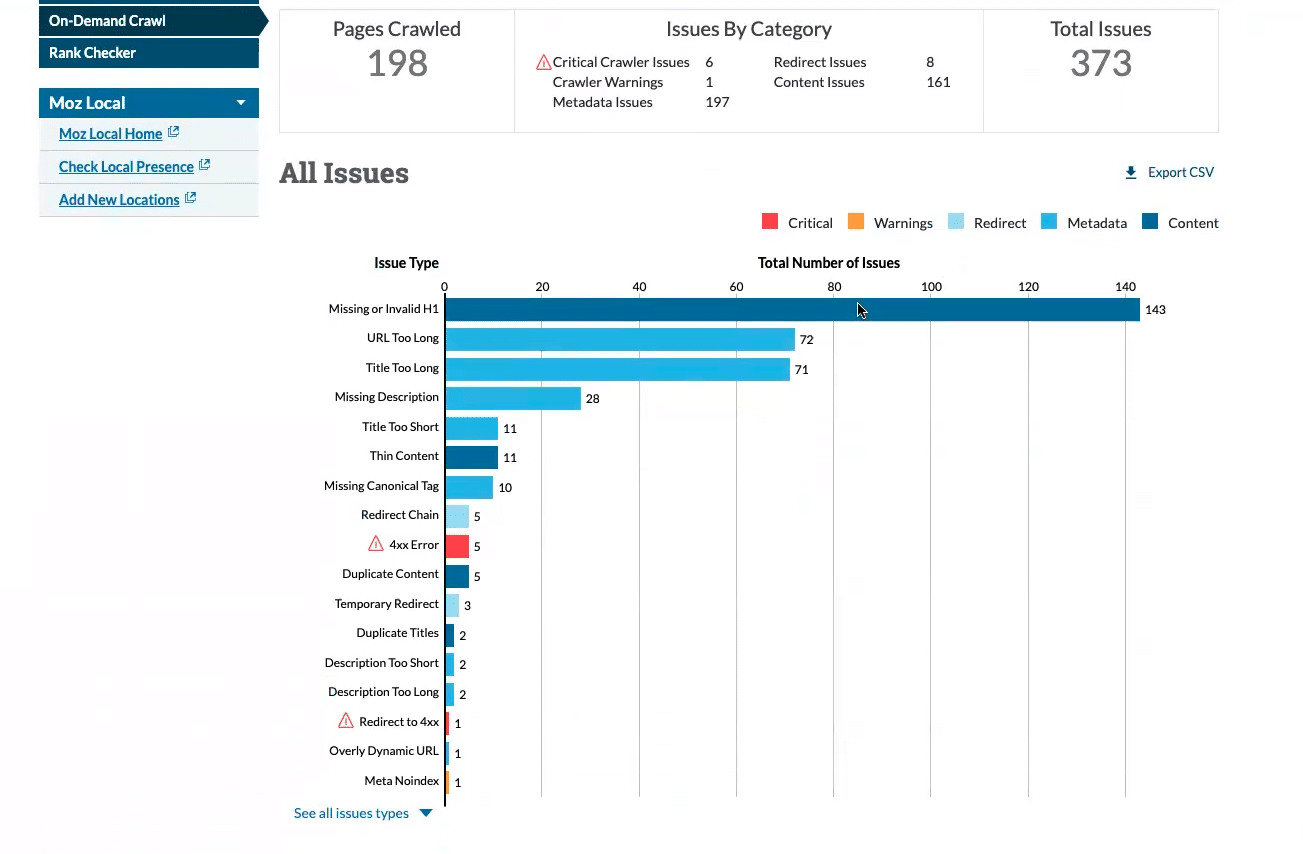
3. Conduct a website crawl
Now that you’ve established your baseline, it’s time to discover your biggest areas for improvement. Use a site such as Moz, Semrush or Ahrefs to run an on-demand crawl of your site.
These tools will do the dirty work for you. They’ll help you identify common SEO mishaps that might be affecting your rank and usability: missing H1 tags, overly-long URLs, missing meta descriptions, 404 errors, etc.
A website crawl helps you identify the highest priorities to triage and some low-hanging fruit to chip away at; i.e., the easy fixes that you can make without much extra work.
4. Address website crawl outputs
Now it’s time to take action based on the outputs of your website crawl. Here are two examples of crawl outputs that you should take action on:
Duplicate content
Your SEO audit might uncover instances of duplicate content. For example: Let’s say you wrote a guest blog for a partner’s website and also posted that same blog on your own site. Google might penalize you in search results for content that closely matches another page.
Typical crawl tools will flag duplicate titles, headings, and meta descriptions (the short summary of a web page’s content that appears in the results page of a search engine). Often this happens because of an automatic title tag creation, or when pages are duplicated and those elements aren’t updated.
Unique meta descriptions give visitors context of what is on the page when it appears in search. When search engines crawl your site and come across duplicate content, it risks harming your SERP rankings because it can’t differentiate the page content and value.
You can also have duplicate content warnings because of URL mismanagement. Depending on your page and post structure, your site might include pagination or categorization tags that can append to URLs, and overtime create messy URL structures. This can also be caused by tracking URL parameters. Examples of this would be:
https://www.eample.com/blog/
https://www.eample.com/blog/page1
https://www.eample.com/blog/?utm_source=linkedin&utm_medium=social&utm_campaign=may2024
Although the above URLs render the same results in most website systems, search engines see them as completely different pages. One way around this is using a canonical tag, which essentially helps Google decide which version of the duplicate content should show up in search results.
URLs
Google tends to prefer URLs that are short, descriptive and include relevant keywords. If your technical SEO audit shows URLs that are too long or complicated, you should plan to simplify them per Google best practices. You may also run into issues with broken links (404 links that lead to error messages for your site visitors) and outdated URLs.
Any time a link is updated, you must create a 301 or 302 redirect to the new page. A 301 redirect tells Google your page’s new permanent location, while a 302 redirect indicates a temporary move. Use 301 when your URL changes permanently, and 302 when you’ll return to the original URL eventually.
For example: you might create a landing page for an annual conference. Once the 2023 conference has passed, you can use a 301 redirect to send traffic to your new 2024 conference landing page.
Google recognizes each version of the page, even if you update the URL. You need to tell Google that the former URL needs to be pointed to the new URL. But also be on the lookout for redirect chains within your crawl; if you have a redirect to a URL that is now also redirecting to another URL, that will cause slower UX and should be updated to point to the final URL. Addressing redirect chains mitigates lost link equity, slow page load and delayed crawling.
The free Redirection plugin on WordPress can help you easily add 301 redirects. Yoast’s Premium plugin manages 301 redirects as well as sitemaps and metadata for a complete SEO suite.
5. Assess your mobile-friendliness
Mobile devices account for 60% of online traffic. In most cases, Google will prioritize sites that function well on desktop computers, tablets and smartphones. You’re looking for a responsive design that provides a seamless user experience on any screen size.
There are plenty of free tools to help you test your site’s mobile-friendliness, including PageSpeed Insights. (More on that in a second!)
For SaaS websites, It’s important to consider the context of your site in the desktop vs. mobile conversation. For example, if your Google Search Console/Google Analytics analysis shows you that only 1% of your traffic comes through mobile, you might not have to spend as much time on ensuring a mobile-friendly user experience. Every site is different!
6. Evaluate your schema markup and structured data
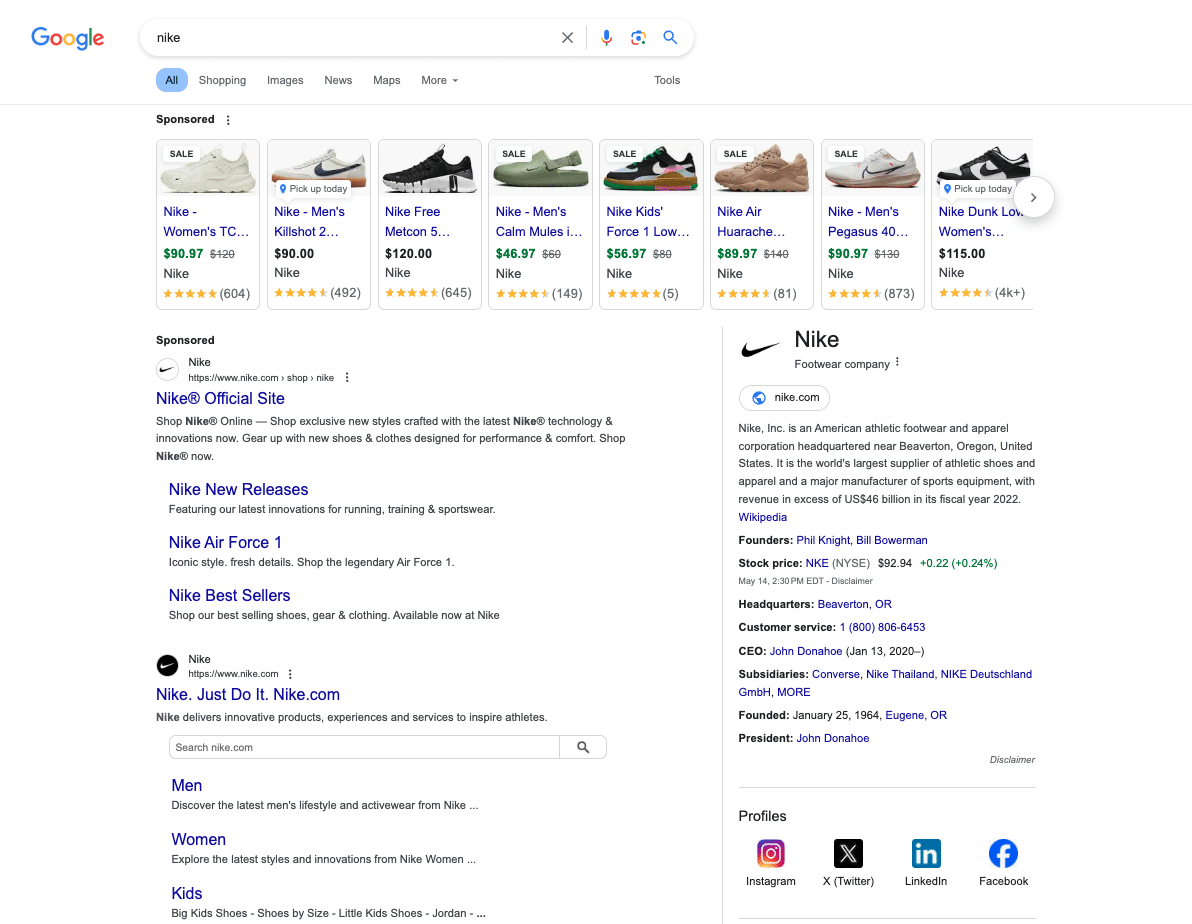
Now we’re getting to the more advanced aspects of the technical SEO audit checklist.
Schema markup, also known as structured data, helps search engines more effectively understand the context and content of your pages. If you’ve ever searched for a term and seen extra information on the side or top of the page (not in the standard search results), you’ve read schema markup.
Note the screenshot above. A Google search for “Nike” doesn’t just prompt a list of websites. It also includes sponsored shopping options, information about the company and links to social profiles. These are all examples of structured data.
Spoiler alert: Google has another free tool to help you out! Check out Google’s Structured Data Markup Helper to improve your chances of appearing in featured snippets and other enhanced search results.
7. Optimize for page speed
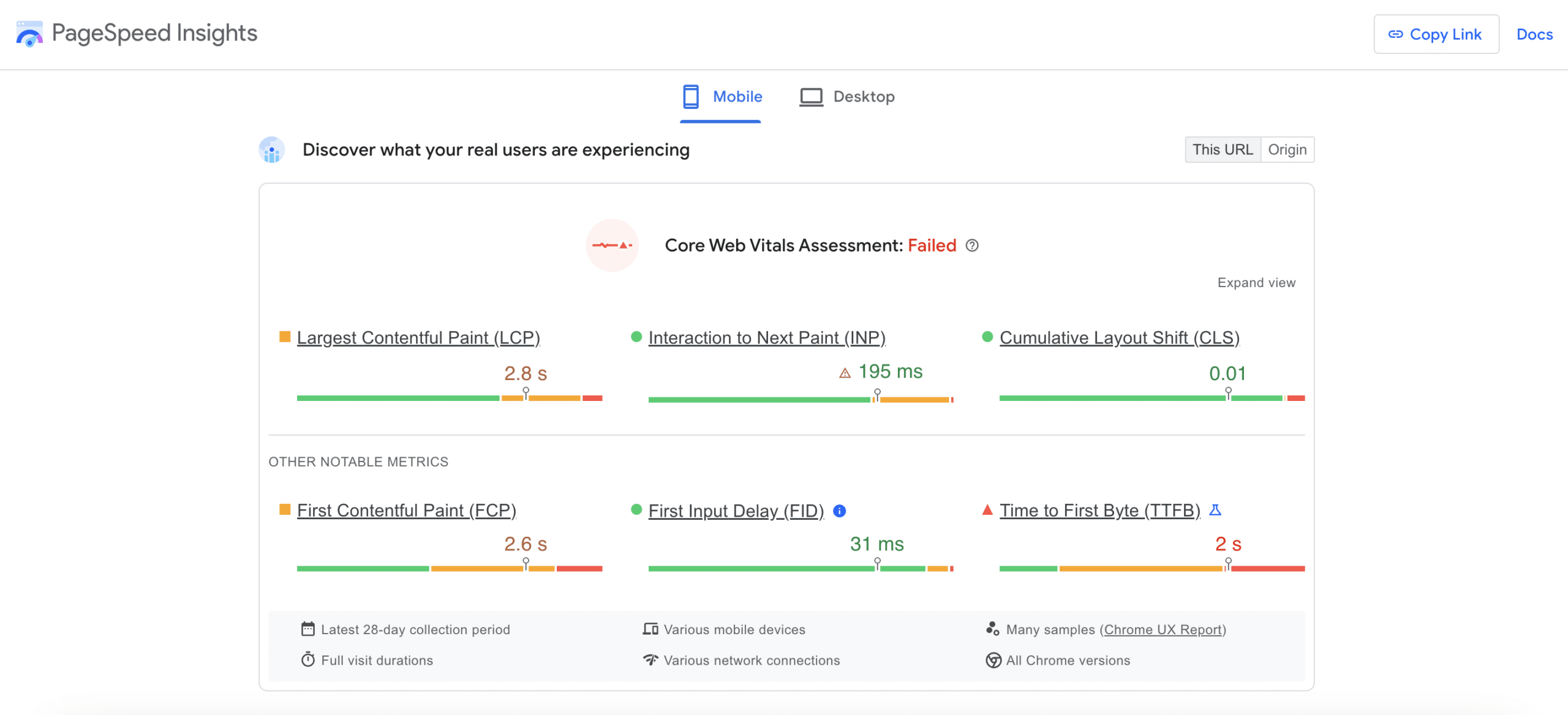
Page loading speed factors in technical SEO. You can use website performance tools like PageSpeed Insights to run a site speed test and analyze what might be bogging your performance down on the backend.
This will give you feedback and suggestions on how to improve your page load speed and overall user experience. Some common alerts include:
- Largest Contentful Paint (LCP) element: LCP measures when the largest content element in the viewport is rendered to the screen. This estimates when the main content of the page is visible to users.
- Eliminate render-blocking resources: This indicates that resources are blocking the first paint of your page. Consider delivering critical JS/CSS inline and deferring all non-critical JS/styles.
- Reduce unused CSS: Reduce unused rules from stylesheets and defer CSS not used for above-the-fold content to decrease bytes consumed by network activity.
- Serve images in next-gen formats: Image formats like WebP and AVIF often provide better compression than PNG or JPEG, which means faster downloads and less data consumption.
Manual backend development and/or plugins can help you address performance issues. Remember: these tools give you a snapshot in time and can fluctuate on performance metrics. Page Speed Insights relies on lab data and preset device/network configurations, so it may not perfectly mirror the user experience. Additionally, the test’s route to the server can fluctuate, leading to longer response times and reduced scores.
8. Set up automatic technical SEO updates
Most great business websites are constantly updated. Setting up automations will help keep your site optimized even as you add and tweak content. There are various plugins and tools you can use to ensure your content remains crawlable, indexable and searchable.
For example, a plugin such as Yoast for WordPress will automatically update your XML site map and robots.txt file over time.
Your website is like the digital storefront of your business. To turn your website into a lead magnet, you’ll need to a.) drive more quality traffic to your site and b.) deliver an excellent user experience. A top-notch technical SEO strategy can help you achieve both goals.
Happy crawling, indexing, and ranking!



